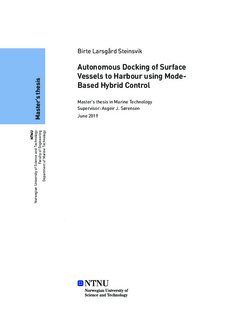| dc.contributor.advisor | Asgeir J. Sørensen | |
| dc.contributor.author | Birte Larsgård Steinsvik | |
| dc.date.accessioned | 2019-10-17T14:03:03Z | |
| dc.date.available | 2019-10-17T14:03:03Z | |
| dc.date.issued | 2019 | |
| dc.identifier.uri | http://hdl.handle.net/11250/2622929 | |
| dc.description.abstract | Teknologien utviklar seg raskt og digitalisering er i vinden i alle delar av samfunnet. Den maritime industrien er ikkje eit unntak, og teknologiske løysingar vert implementert overalt for å auke effektivitet og sikkerheit. Moglegheitene for å ha fullt autonome skip som utfører visse operasjonar vert forska på av fleire selskap. Utfordringane i autonom shipping varierer frå baneplanlegging og anti-kollisjonssystem til autonom dokking. Dokkingsprosessen av eit overflatefartøy til ei hamn er ein høgrisikooperasjon som krev presisjon og er ofte tidsavgrensa. Denne mastergradsoppgåva presenterer eit modusbasert hybridstyringssystem for autonom dokking av overflatefartøy til hamn.
Hybridstyringssystemet består av ein bank med regulatorar som svarer til dei ulike driftsmodusane for DP, tillegging og ved kai, og frålegging. Eit rettleiingssystem er brukt til å bytte mellom regulatorane når skipet er i dei ulike modusane. To forskjellige metodar for frålegging er utvikla; UNB1 og UNB2. UNB1 bruker DP-regulatoren, medan UNB2 bruker ein separat fråleggingsregulator. For begge metodane er referansemodellen tilbakestilt for å oppnå ønska yting. Referansemodellen er tilbakestilt ved å implementere ein sekundær referansemodell med settpunkt utanfor kaia. Den sekundære referansemodellen vert bytta til i fasa for frålegging. For UNB2 er ein algoritme for forovekopling av vindkrefter implementert for å generere nok kraft til å legge frå kai i vind.
Ein case-studie er utført for å vise ytinga til dokkingsalgoritmen gjennom simulering. Simuleringsresultata viser at det er hensiktsmessig å tilbakestille referansemodellen ved frålegging for både UNB1 og UNB2. For UNB1 gir tilbakestillinga av referansemodellen nok fråleggings kraft for å kunne legge frå raskt, medan for UNB2 sikrar tilbakestillinga av referansemodellen ei jamn bane. Vidare viser simuleringsresultata korleis dokkingalgoritmen yter når vind er påført medan skipet ligg til kai.
Under frålegging med UNB1 og påførte vindkrefter, er ytinga avhengig av avstanden mellom kaia og sekundær settpunktet. Eit settpunkt nær kaia skaper mindre kraft enn eit settpunkt lenger vekk frå kaia. Derfor, med vind aktivert mot kaia, gir plassering av settpunktet lenger frå kaia den beste ytinga.
Under frålegging med UNB2 og påførte vindkrefter, er ytinga avhengig av nøyaktigheita av foroverkopliga av vindkreftene. Simuleringsresultata samanliknar evna fartøyet har til å legge frå kai med og utan foroverkopling av vindkrefter, der foroverkoplinga er 100% nøyaktig. I røynda vil nøyaktigheita av vindmålingane aldri være 100%. Uansett, er algoritmen for foroverkopling av vindkrefter i stand til å endre fråleggings-krafta til ein meir passande storleik enn utan foroverkoplinga. | |
| dc.description.abstract | The technology is rapidly evolving and digitalisation is a buzzword in all parts of the community. The maritime industry is not an exception and technological solutions are being implemented everywhere to increase efficiency and safety. The possibilities of having fully autonomous ships conducting certain operations are being explored by several companies. The challenges in autonomous shipping range from path planning and collision avoidance to autonomous docking. The docking process of a surface vessel to a harbour is a high-risk operation that demands precision and is often time strained. This master's thesis presents a mode-based hybrid control system for autonomously docking of surface vessels to harbour.
The hybrid control system consists of a controller bank with controllers corresponding to the operation use modes of DP, berthing and quayside, and unberthing. A supervisory switch system is used for switching between the controllers when the different modes are entered. Two different methods of unberthing are developed; UNB1 and UNB2. UNB1 uses the DP controller, while UNB2 uses a separate unberthing controller. For both methods, the reference model is reset in order to achieve the desired performance. The reference model is reset by implementing a secondary reference model with a set-point outside of the quay. The secondary reference model is switched to upon unberthing. For UNB2 a wind feedforward algorithm is implemented to generate enough unberthing force when wind loads act on the vessel.
A case-study is conducted to show by simulation the performance of the docking algorithm. The simulation results show the expediency of resetting the reference model for unberthing for both UNB1 and UNB2. For UNB1 the reset of the reference model gives enough unberthing force to be able to unberth rapidly, while for UNB2 the reset of the reference model ensures a smooth path. Further, the simulation results show the performance of the docking algorithm with wind applied during the vessel's time at the quayside.
During unberthing with UNB1 and wind forces applied, the performance is dependent on the distance to the quay of the secondary set-point. A set-point close to the quay creates less force than a set-point further from the quay. Hence, with wind enabled towards the quay, placing the set-point further from the quay gives the best performance.
During unberthing with UNB2 and wind forces applied, the performance is dependent on the accuracy of the wind feedforward algorithm. The simulation results compare the ability the vessel has to unberth with no wind feedforward algorithm and with a 100% accurate wind feedforward. In real life, the accuracy of the wind measurements will never be 100%. Regardless, the wind feedforward algorithm is able to alter the unberthing force to a more suiting magnitude than without the wind feedforward algorithm. | |
| dc.language | eng | |
| dc.publisher | NTNU | |
| dc.title | Autonomous Docking of Surface Vessels to Harbour using Mode-Based Hybrid Control | |
| dc.type | Master thesis | |
